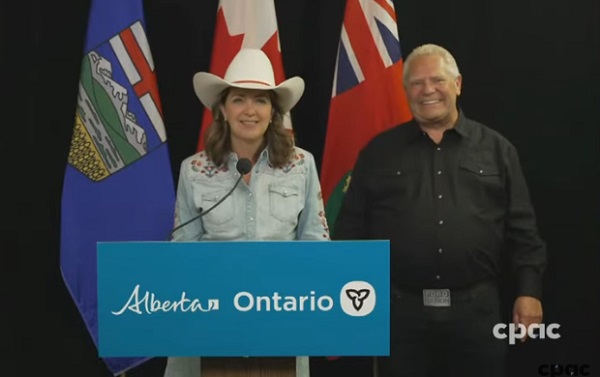Energy
Trump’s plans should prompt Ottawa to reverse damaging policies aimed at oil and gas

From the Fraser Institute
By Tegan Hill
Adding to a long list of costly federal policies that restrict oil and gas development, the Trudeau government plans to cap greenhouse gas emissions from the oil and gas sector at 35 per cent below 2019 levels by 2030. This is the exact opposite of what Canada needs, particularly given developments south of the border.
President-elect Donald Trump has made it clear he aims to boost U.S. oil and gas production. Pledging to “drill, drill, drill,” Trump will lift restrictions on liquified natural gas exports, expedite drilling permits, and expand offshore oil production through new lease sales. He also plans to create a National Energy Council to establish U.S. “energy dominance” by “cutting red tape, enhancing private sector investments across all sectors of the economy, and by focusing on innovation over long-standing, but totally unnecessary, regulation.” These changes will lower the cost of oil and gas development in the U.S., which means production will increase and commodity (e.g. crude oil) prices will likely drop in the U.S., Canada and beyond.
Of course, this might lower prices at the pump, lower home-heating bills and bring good news for consumers. But policymakers should understand that lower commodity prices would be a big hit for provincial budgets in Alberta, Saskatchewan and Newfoundland and Labrador, which rely heavily on resource revenues. In Alberta, for example, a $1 decline in the price of oil results in an estimated $630 million loss to the provincial treasury. The federal government will also take a hit. In 2022 (the latest year of available data), Canada’s oil and gas industry paid the federal government more than $9 billion in corporate income taxes.
And because the Trudeau government has introduced numerous new regulations that restrict oil and gas development, it would be very difficult for the industry to increase sales volume to offset any loss. And according to a recent report by Deloitte, the government’s proposed emissions cap will curtail oil production by 626,000 barrels per day by 2030 or by approximately 10.0 per cent of the expected production—and curtail gas production by approximately 12.0 per cent.
There’s also Bill C-69 (the “Federal Impact Assessment Act”), which overhauled Canada’s federal environmental review process making the regulatory system more complex, uncertain and subjective. And Bill C-48, which bans large oil tankers off British Columbia’s northern coast, presenting another barrier to exporting to Asia. All of these policies make Canada, and particularly energy-producing provinces such as Alberta, Saskatchewan and Newfoundland and Labrador, less attractive for investment.
Indeed, according to the latest survey of oil and gas investors published by the Fraser Institute, 50 per cent of survey respondents said the “stability, consistency and timeliness of environmental regulatory process” in Alberta scared away investment compared to only 11 per cent in Texas. Similarly, 42 per cent of respondents said “uncertainty regarding the administration, interpretation, stability, or enforcement of existing regulations” was a deterrent to investment in Alberta compared to 13 per cent in Texas. And 43 per cent of respondents said the cost of regulatory compliance was a deterrent to investment in Alberta compared to 19 per cent for Texas. Without strong investment, energy-producing provinces won’t be able to increase production.
Trump’s plan to reduce regulations and bolster U.S. oil and gas production will lead to lower prices for oil and gas. While that’s good news for consumers, policymakers should understand how the new normal will impact government coffers. To offset the loss associated with lower prices and lower revenue, provinces need more natural resource development. But that will require the Trudeau government to reverse its damaging policies and abandon its emissions cap plan.
Automotive
Federal government should swiftly axe foolish EV mandate

From the Fraser Institute
Two recent events exemplify the fundamental irrationality that is Canada’s electric vehicle (EV) policy.
First, the Carney government re-committed to Justin Trudeau’s EV transition mandate that by 2035 all (that’s 100 per cent) of new car sales in Canada consist of “zero emission vehicles” including battery EVs, plug-in hybrid EVs and fuel-cell powered vehicles (which are virtually non-existent in today’s market). This policy has been a foolish idea since inception. The mass of car-buyers in Canada showed little desire to buy them in 2022, when the government announced the plan, and they still don’t want them.
Second, President Trump’s “Big Beautiful” budget bill has slashed taxpayer subsidies for buying new and used EVs, ended federal support for EV charging stations, and limited the ability of states to use fuel standards to force EVs onto the sales lot. Of course, Canada should not craft policy to simply match U.S. policy, but in light of policy changes south of the border Canadian policymakers would be wise to give their own EV policies a rethink.
And in this case, a rethink—that is, scrapping Ottawa’s mandate—would only benefit most Canadians. Indeed, most Canadians disapprove of the mandate; most do not want to buy EVs; most can’t afford to buy EVs (which are more expensive than traditional internal combustion vehicles and more expensive to insure and repair); and if they do manage to swing the cost of an EV, most will likely find it difficult to find public charging stations.
Also, consider this. Globally, the mining sector likely lacks the ability to keep up with the supply of metals needed to produce EVs and satisfy government mandates like we have in Canada, potentially further driving up production costs and ultimately sticker prices.
Finally, if you’re worried about losing the climate and environmental benefits of an EV transition, you should, well, not worry that much. The benefits of vehicle electrification for climate/environmental risk reduction have been oversold. In some circumstances EVs can help reduce GHG emissions—in others, they can make them worse. It depends on the fuel used to generate electricity used to charge them. And EVs have environmental negatives of their own—their fancy tires cause a lot of fine particulate pollution, one of the more harmful types of air pollution that can affect our health. And when they burst into flames (which they do with disturbing regularity) they spew toxic metals and plastics into the air with abandon.
So, to sum up in point form. Prime Minister Carney’s government has re-upped its commitment to the Trudeau-era 2035 EV mandate even while Canadians have shown for years that most don’t want to buy them. EVs don’t provide meaningful environmental benefits. They represent the worst of public policy (picking winning or losing technologies in mass markets). They are unjust (tax-robbing people who can’t afford them to subsidize those who can). And taxpayer-funded “investments” in EVs and EV-battery technology will likely be wasted in light of the diminishing U.S. market for Canadian EV tech.
If ever there was a policy so justifiably axed on its failed merits, it’s Ottawa’s EV mandate. Hopefully, the pragmatists we’ve heard much about since Carney’s election victory will acknowledge EV reality.
Daily Caller
Trump Issues Order To End Green Energy Gravy Train, Cites National Security


From the Daily Caller News Foundation
By Audrey Streb
President Donald Trump issued an executive order calling for the end of green energy subsidies by strengthening provisions in the One Big Beautiful Bill Act on Monday night, citing national security concerns and unnecessary costs to taxpayers.
The order argues that a heavy reliance on green energy subsidies compromise the reliability of the power grid and undermines energy independence. Trump called for the U.S. to “rapidly eliminate” federal green energy subsidies and to “build upon and strengthen” the repeal of wind and solar tax credits remaining in the reconciliation law in the order, directing the Treasury Department to enforce the phase-out of tax credits.
“For too long, the Federal Government has forced American taxpayers to subsidize expensive and unreliable energy sources like wind and solar,” the order states. “Reliance on so-called ‘green’ subsidies threatens national security by making the United States dependent on supply chains controlled by foreign adversaries.”
Dear Readers:
As a nonprofit, we are dependent on the generosity of our readers.
Please consider making a small donation of any amount here.
Thank you!
Former President Joe Biden established massive green energy subsidies under his signature 2022 Inflation Reduction Act (IRA), which did not receive a single Republican vote.
The reconciliation package did not immediately terminate Biden-era federal subsidies for green energy technology, phasing them out over time instead, though some policy experts argued that drawn-out timelines could lead to an indefinite continuation of subsidies. Trump’s executive order alludes to potential loopholes in the bill, calling for a review by Secretary of the Treasury Scott Bessent to ensure that green energy projects that have a “beginning of construction” tax credit deadline are not “circumvented.”
Additionally, the executive order directs the U.S. to end taxpayer support for green energy supply chains that are controlled by foreign adversaries, alluding to China’s supply chain dominance for solar and wind. Trump also specifically highlighted costs to taxpayers, market distortions and environmental impacts of subsidized green energy development in explaining the policy.
Ahead of the reconciliation bill becoming law, Trump told Republicans that “we’ve got all the cards, and we are going to use them.” Several House Republicans noted that the president said he would use executive authority to enhance the bill and strictly enforce phase-outs, which helped persuade some conservatives to back the bill.
-

 Bruce Dowbiggin2 days ago
Bruce Dowbiggin2 days agoEau Canada! Join Us In An Inclusive New National Anthem
-

 Crime2 days ago
Crime2 days agoEyebrows Raise as Karoline Leavitt Answers Tough Questions About Epstein
-

 Business2 days ago
Business2 days agoCarney’s new agenda faces old Canadian problems
-

 Alberta2 days ago
Alberta2 days agoCOWBOY UP! Pierre Poilievre Promises to Fight for Oil and Gas, a Stronger Military and the Interests of Western Canada
-

 Alberta2 days ago
Alberta2 days agoAlberta and Ontario sign agreements to drive oil and gas pipelines, energy corridors, and repeal investment blocking federal policies
-

 Crime1 day ago
Crime1 day ago“This is a total fucking disaster”
-

 International2 days ago
International2 days agoChicago suburb purchases childhood home of Pope Leo XIV
-

 Fraser Institute1 day ago
Fraser Institute1 day agoBefore Trudeau average annual immigration was 617,800. Under Trudeau number skyrocketted to 1.4 million annually







